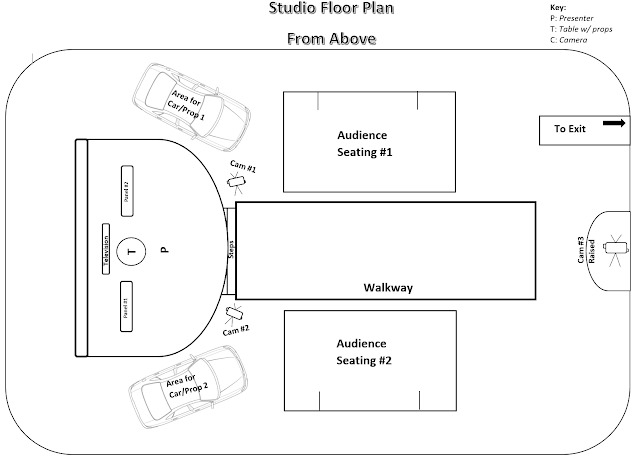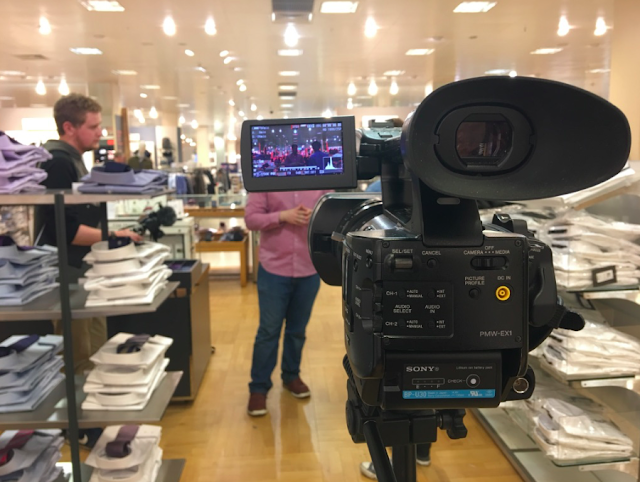As Live Production Research - Studio Based Factual Analysis - Top Gear
Top Gear - Studio Based Factual Analysis
Top Gear is one of the most popular shows to grace our television screens. It is a British television show about motor vehicles, primarily cars, and is still the world's most widely watched factual television programme. While the show originated as an automobile enthusiast magazine back in 1977, it quickly became something more during their 2002 relaunch, followed by the commissioning of the 'Top Gear' show by the BBC. The show is estimated to have approximately 350 million views per week in over 160 different countries.
Following the BBC's recent fallout with Jeremy Clarkson, the show continued to sail through the mainstream rather smoothly and without controversy, however after said incident the show underwent a major rebranding - complete with 3 new hosts and a completely different tone, it was met with much criticism from the audience and general public as a whole. During this analysis I will be referring exclusively to 'Top Gear' BEFORE the rebranding occured.
The opening title sequence has become almost as well known as the show - It's now a TV icon, along with the remixed theme tune from the rock instrumental 'Jessica'. Dramatic looking shots establish the show's characteristics clearly within the audience's mind via visually stimulating automobile imagery. These depictions are colourful and contrasted, hinting at the excitement/drama to come. During the latter half of Clarkson, Hammond and May's tenure over the show, they implemented a smoother opening credits sequence, conforming to the 'slick', smooth movements are more comparable to that of modern cinematography & animation.
Top Gear itself can be broken down into several core segments of the show, not all are included in every episode but can vary between the following;
 In it's regular format the show is often a mixture between in-studio interviews and PTC's (Pieces to Camera), along with at least 2 VT segments in which Jeremy Clarkson, James May and Richard Hammond go on adventures together, take on various different challenges and address concerns from car enthusiasts, manufacturers and dealers. The in-studio pieces and particularly the 'Top Gear' brand have become synonymous with the idea of a standing audience. The show's set is designed to be like an automobile garage/warehouse, with the the presenters either standing in the centre of the crowded audience, or the presenters and a guest at a seated area, accompanied by a plasma screen, also surrounded by a standing audience. (pictured right)
In it's regular format the show is often a mixture between in-studio interviews and PTC's (Pieces to Camera), along with at least 2 VT segments in which Jeremy Clarkson, James May and Richard Hammond go on adventures together, take on various different challenges and address concerns from car enthusiasts, manufacturers and dealers. The in-studio pieces and particularly the 'Top Gear' brand have become synonymous with the idea of a standing audience. The show's set is designed to be like an automobile garage/warehouse, with the the presenters either standing in the centre of the crowded audience, or the presenters and a guest at a seated area, accompanied by a plasma screen, also surrounded by a standing audience. (pictured right)
Top Gear is one of the most popular shows to grace our television screens. It is a British television show about motor vehicles, primarily cars, and is still the world's most widely watched factual television programme. While the show originated as an automobile enthusiast magazine back in 1977, it quickly became something more during their 2002 relaunch, followed by the commissioning of the 'Top Gear' show by the BBC. The show is estimated to have approximately 350 million views per week in over 160 different countries.
Following the BBC's recent fallout with Jeremy Clarkson, the show continued to sail through the mainstream rather smoothly and without controversy, however after said incident the show underwent a major rebranding - complete with 3 new hosts and a completely different tone, it was met with much criticism from the audience and general public as a whole. During this analysis I will be referring exclusively to 'Top Gear' BEFORE the rebranding occured.
The opening title sequence has become almost as well known as the show - It's now a TV icon, along with the remixed theme tune from the rock instrumental 'Jessica'. Dramatic looking shots establish the show's characteristics clearly within the audience's mind via visually stimulating automobile imagery. These depictions are colourful and contrasted, hinting at the excitement/drama to come. During the latter half of Clarkson, Hammond and May's tenure over the show, they implemented a smoother opening credits sequence, conforming to the 'slick', smooth movements are more comparable to that of modern cinematography & animation.
Top Gear itself can be broken down into several core segments of the show, not all are included in every episode but can vary between the following;
- Car Reviews
- Races
- Challenges
- Star in a Reasonably Priced Car
- Power Laps
- The Cool Wall
- Top Gear Awards
- The News
Every now and then 'Top Gear' has episodes that break this format entirely, often labelled as 'Top Gear Special: X', some of these include 'Top Gear: Vietnam Special', 'Top Gear: Middle-East Special', and 'Top Gear: India Special'. These involve road trips and antics across a foreign country, but consist almost entirely of VT, therefore the studio application is used sparingly during these particular episodes.
 In it's regular format the show is often a mixture between in-studio interviews and PTC's (Pieces to Camera), along with at least 2 VT segments in which Jeremy Clarkson, James May and Richard Hammond go on adventures together, take on various different challenges and address concerns from car enthusiasts, manufacturers and dealers. The in-studio pieces and particularly the 'Top Gear' brand have become synonymous with the idea of a standing audience. The show's set is designed to be like an automobile garage/warehouse, with the the presenters either standing in the centre of the crowded audience, or the presenters and a guest at a seated area, accompanied by a plasma screen, also surrounded by a standing audience. (pictured right)
In it's regular format the show is often a mixture between in-studio interviews and PTC's (Pieces to Camera), along with at least 2 VT segments in which Jeremy Clarkson, James May and Richard Hammond go on adventures together, take on various different challenges and address concerns from car enthusiasts, manufacturers and dealers. The in-studio pieces and particularly the 'Top Gear' brand have become synonymous with the idea of a standing audience. The show's set is designed to be like an automobile garage/warehouse, with the the presenters either standing in the centre of the crowded audience, or the presenters and a guest at a seated area, accompanied by a plasma screen, also surrounded by a standing audience. (pictured right)
One of the things I hope to be able to emulate with 'Steal the Style' is the laid back environment that Top Gear has come to be known for. Their informal approach to both set design and audience placement is to be at the very least commended, especially considering the lengthy 10+ year tenure the show and format has endured at this point.
While a large focus of 'Top Gear' is infact the VT material, the in-studio segments are absolutely crucial to forming a cohesive format for the show, transitioning between different segments and ensuring the production goes as fluidly as possible. Unlike 'Steal the Style', the show isn't live television which is worth noting, though there's still much to be learned in terms of the format of the show, the in-studio segments specifically, and the ways in which they incorporate their audience into the set itself.
While a large focus of 'Top Gear' is infact the VT material, the in-studio segments are absolutely crucial to forming a cohesive format for the show, transitioning between different segments and ensuring the production goes as fluidly as possible. Unlike 'Steal the Style', the show isn't live television which is worth noting, though there's still much to be learned in terms of the format of the show, the in-studio segments specifically, and the ways in which they incorporate their audience into the set itself.



Comments
Post a Comment